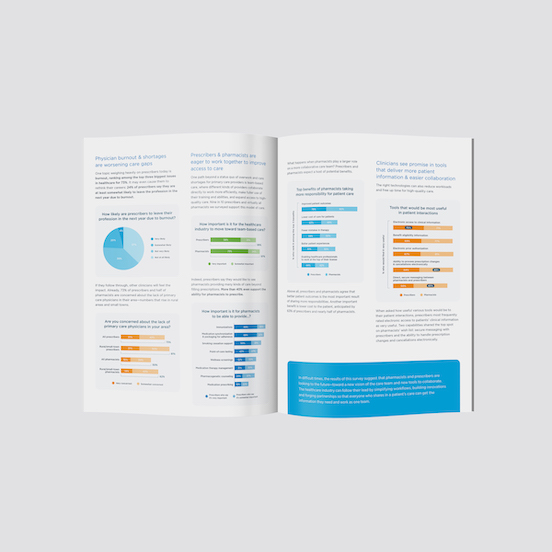We’ve got our sights set on writing a new ending to the patient access-to-care story, with the first chapter bringing to light what we’ve all heard before: significant and growing gaps in primary care access with just one primary care provider (PCP) for every 1,500 people in nearly half of the 3,233 U.S. counties.
As the story continues, we needed to dig deeper at the source. We surveyed 509 prescribers and pharmacists who shared the top challenges they are facing and what changes they see that may help us draft a new ending to the patient care story.
There’s Always More to The Story
Provider burnout tops the list of concerns for a significant majority of the prescribers across the country who shared their experiences as part of a recent Surescripts survey.

Clinicians Concerned By Primary Care Shortages See Promise In Technology
New data shows most prescribers and pharmacists agree team-based care benefits patients and lowers costs.
But as we turn the page, we’re seeing new details come to light: both prescribers and pharmacists agree that team-based care is a priority and even a majority of providers believe it’s important for the industry to move to team-based care.
This data illustrates a somewhat dramatic pivot away from a long-held narrative that prescribers and pharmacists must have distinct and separate roles when delivering care to patients.
There was also strong agreement that the top benefit of pharmacists providing more clinical or primary care for patients is improved patient outcomes, according to 78% of prescribers and 92% of pharmacists, not to mention a majority who believe team-based care would decrease the total cost of care for patients.
Problem Solved? Not Quite.
While providers agree that a team-based approach will benefit patients, there are other challenges that stand in the way of improving the delivery of patient care. But clinicians see promise in tools that deliver more patient information and easier collaboration and a majority of all clinicians surveyed agree that certain tools would be very useful, including:
- Nearly three-quarters of prescribers and pharmacists agree electronic access to clinical information would be very useful
- More than two thirds of clinicians agree benefit eligibility information and electronic prior authorization would be very useful
- Half of prescribers and more than 80% of pharmacists would also find direct, secure messaging between pharmacists and prescribers would be very useful
I’m reminded of what my colleague Dr. Eric Weidmann, Chief Medical Officer, CompuGroupMedical eMDs, shared about communication between providers during a panel discussion back in April. He said, “I don't think this is new dynamics at all. This is old school. When Frank and I started in practices, we had verbal relationships regularly with our pharmacy colleagues around our neighboring pharmacies. We knew their voices; we knew their names. They hated my handwriting, just all the typical things.”
“But it was a collaboration and it helped us both work at the top of our licenses,” Dr. Weidmann added.
Dr. Weidmann is right – connecting prescribers and pharmacists allows everyone to work more efficiently and collaboratively, restoring their focus on what matters most – their patients. Technology today can automate administrative tasks and facilitate effective communication but there’s certainly more innovation needed to enhance the care team approach.
Streamlining workflows helps clinicians operate as a team
E-Prescribing transactions like CancelRx, RxChange and RxTransfer let prescribers and pharmacists exchange information promptly within their electronic workflows, without faxes or phone calls.
Real-Time Prescription Benefit is letting pharmacists access patient-specific insights without spending time on the phone with prescribers and benefit plans.
Our Specialty Medications solutions give specialty pharmacies the clinical information needed to provide patient support during processes like enrollment and prior authorization—reducing calls and faxes for clinicians as well as inquiries for the patient.
Clinical Direct Messaging lets pharmacists, prescribers and other healthcare professionals reliably send and receive information—such as immunization records—across multiple care collaboration scenarios within their existing workflows.
A Fuller Story That’s Ready To Tell
It is also important to point out that a majority of providers surveyed say they are likely to leave the profession in the next year due to dissatisfaction. In addition, more than half of prescribers and pharmacists reported they are very or somewhat concerned about the lack of PCPs in their area – which is not a uniquely rural issue.
The need to advance clinical interoperability and technology to support a changing care dynamic is becoming even more crucial.
Dr. Anita Patel, Pharm.D. and Vice President of Pharmacy Services Development at Walgreens, noted as part of the panel discussion, “technology and appropriate patient information will allow pharmacists to provide clinical care, including immunizations, medication counseling and important health screenings, allowing them to serve as effective members of patient care teams, improving healthcare in a different way than before.”
The providers’ responses back up what Dr. Patel shared:
- Pharmacists have a stronger desire for tools to help
- More than half of pharmacists would like to provide pharmacogenetic testing
And prescribers see the importance of pharmacists providing more care services. A majority of prescribers surveyed believe it is either very important or somewhat important that pharmacists be able to provide the following:
- Immunization administration (95% of prescribers)
- Smoking cessation (81%)
- Point of care testing (70%)
- Wellness screenings (65%)
- Medication therapy management (61%)
Dr. Patel added, “there are opportunities emerging for pharmacists to practice at the full scope of their license, providing care that compliments physicians’ treatment plans and filling gaps in access to care.”
To Be Continued…
With even more facts backing up what we’ve known for a while, there’s greater urgency to improve healthcare by ensuring that the policies, payment structure and technology are in place to truly empower clinicians and guarantee patients have accessible, affordable, quality healthcare.
The kind of happy ending we would all like to see.
Learn more about how Surescripts is supporting the evolving care team with interoperability.


 Dean Riggott Photography
Surescripts
Dean Riggott Photography
Surescripts


